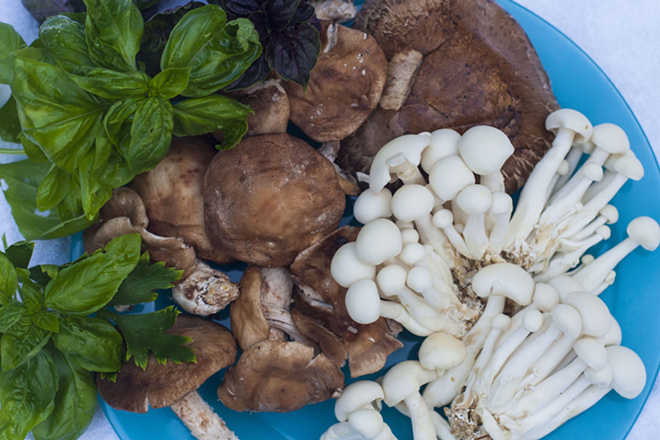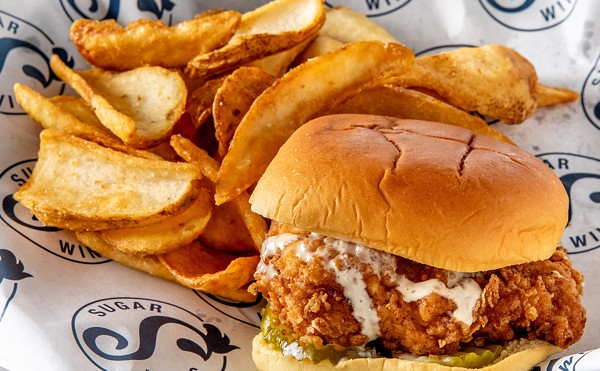Mushrooms, long revered in Asian cultures for millennia as a cooking staple and potent enhancer of health, are rapidly captivating the attention of the Western world.
Appearing more frequently on restaurant menus and mainstream grocery store shelves, mushrooms and mushroom supplements are gaining popularity for their medicinal powers.
The Chinese have one of the most sophisticated uses of medicinal mushrooms and have a written history of using them that dates back several thousand years. Many medicinal mushrooms, like cordyceps (Cordyceps sinensis) and reishi (Ganoderma lucidum), were so highly prized that only the emperor consumed them.
Medicinal mushrooms were so valued in ancient Japan, too, that the maitake (Grifola frondosa) species were worth their weight in silver.
The button mushroom (Agaricus bisporus) — a common or commercial mushroom — and the portobello — a darker, mature strain of the button — are joined on grocer’s shelves by a number of others, including shiitake, bunapi, turkey tail and oyster mushrooms.
Mushroom studies increased within the last three decades, helping to popularize the fungi and their unique health-boosting effects. Research on medicinal mushrooms indicates various types have potential anti-viral, anti-microbial, anti-cancer, anti-hyperglycemic, cardio-protective and anti-inflammatory activities.
While holistic doctors have recommended them for years, recent studies led mushrooms to appear in more peer-reviewed scientific and medical journals, an essential step toward acceptance and awareness among medical professionals.
Mushrooms are the fruit of fungus, the visible bloom formed from the mycelium, which is the stringy vegetative part of the organism that grows underground. There are thousands of species of mushroom growing in the wild, with differing colors and shapes, but a large percentage of studies focus on three main varieties: reishi, maitake and shiitake.
Reishi has been used in Chinese medicine for 2,000 years, and numerous studies have investigated its anti-cancer and immune-boosting properties. In a 2010 paper published in the U.S. Proceedings of the National Academy of Sciences (PNAS) journal, a team of scientists linked reishi to cancer-cell death.
Believed to have similar qualities, maitake mushrooms stimulated the immune systems of breast cancer patients in a human trial conducted by Memorial Sloan Kettering Cancer Center in 2009.
Meanwhile, shiitake has shown that it lowers cholesterol and blood pressure, inhibits tumors and fights viruses.
Nate Fisher, produce manager at Tampa’s Rollin’ Oats, offers customers a variety of mushrooms, depending on availability. Shiitake is among the top sellers.
“Mushrooms have such a short shelf life, especially the sliced mushrooms, which many prefer,” Fisher said. “Shiitake, along with the button, oyster and portobello, are a little more recognizable to customers but awareness is growing of other species.”
Sales for freeze-dried shiitake, as well as shiitake extracts and supplements, continue to rise nationwide. Several shiitake burger companies have emerged in the last five years.
At Abby’s Health & Nutrition in Tampa, produce manager Sean Jenkins says that consumer interest in mushrooms mirror their concern for healthier dietary choices. Depending on availability, Jenkins offers up to 12 varieties.
"They are a great substitute for meat and are very diverse across the board," Jenkins said.
Considered protein powerhouses, portobello, shiitake and other varieties deliver between 30 and 35 percent protein by weight. Mushrooms also supply potent B vitamins, and are one of the few food sources of vitamin D (primarily in the form of D2).
Clearwater’s Nature’s Food Patch makes the Shroomer sandwich, a customer favorite, with marinated portobello. Like at Rollin' Oats, shiitake mushrooms remain among the best-selling fungi.
The Japanese have used shiitakes for their firm, almost leathery texture and smoky flavor. However, fresh Oriental shiitakes were banned in the United States until 1972 because of unfounded fears that the fungus might infest forests. American cooks had to cut their teeth on dried shiitakes until growers in Pennsylvania and California began growing the first domestic supplies.
Mycologists, mushroom and fungi specialists, believe there are over 1.4 million species of mushrooms on Earth, but only 10 percent have been scientifically named and catalogued.
Mushrooms like the shiitake, wine cap, oyster and lion’s mane have taken to home domestication. All are widely available in spawn form and are reasonably easy to grow. But gourmet varieties, like chanterelles and truffles, continue to defy most human meddling.
Though white button mushrooms account for 95 percent of all cultivated mushrooms in the United States, Americans have developed an appetite for more flavorful and expensive varieties. Smaller farms are cropping up across the nation to meet demand, and backyard growers have also embraced the ease of mushroom farming.
Renowned mycologist and founder of Fungi Perfecti, a company that sells mushroom kits, Paul Stamets believes mushroom consumption will continue to rise along with awareness. Stamets describes mushrooms as miniature pharmaceutical factories that not only boost one’s immune system and prevent illness, but will soon be recognized as a cure for many of the world’s diseases.
According to Stamets, “It’s just a matter of time.”
Popular types of mushrooms used for medicinal purposes
To date, as many as 150 species of mushroom have been identified as medicinal mushrooms. Popular species include button, chaga, cordyceps, shiitake, maitake and reishi mushrooms, and each demonstrate positive impacts on the immune system. Extracts or teas are made from these mushrooms to help improve absorption.
Button This mushroom contain significant amounts of copper, which helps to create red blood cells. According to sources at LiveStrong, “One cup of cooked Button mushrooms supplies the body with 16 percent of the daily value of iron, important for blood and energy, and 12 percent of the daily percentage of vitamin C.”
Chaga This has demonstrated a wide range of beneficial behaviors, including — according to the Memorial Sloan Kettering Cancer Center — anti-cancer, anti-viral, anti-platelet, anti-inflammatory, analgesic, immune-stimulating properties in vitro, and hypoglycemic effects in mice.
Cordyceps A fungi that has been used for a wide range of conditions. In vitro and animal studies have shown it to have anti-tumor, radio-protective and anti-diabetic effects. It has also been used to treat fatigue, sexual dysfunction, coughs and as an immune stimulant.
Shiitake This mushroom is cultivated worldwide for its purported health benefits. Lentinan, a polysaccharide isolated from shiitake, has been shown to have anti-cancer effects in colon cancer cells. Lentin, the protein component, has strong anti-fungal properties as well as other positive immune system effects, such as inhibiting the proliferation of leukemic cells.
Maitake The “dancing mushroom” is used in traditional medicine to treat diabetes and hypertension. Extracts are commonly marketed to enhance immune function and to treat HIV and cancer.
Reishi A mushroom used for more than 4,000 years for a variety of health benefits, including disease resistance and energy, longevity and memory enhancements. Additionally, they have been known to treat cancer, hepatitis and heart disease.
Good read Author and mushroom forager Langdon Cook takes readers on Mr. Toad’s Wild Ride into the often secretive, often shady world of mushroom hunters in The Mushroom Hunter: On the Trail of An Underground America. Passionate about fungi as much as the two hunters he accompanies and writes about throughout most of the book, Cook details the extremes hunters go through, both legally and illegally, to bring many mushrooms from woods to our plates.
Another reason to visit Colorado: Telluride Mushroom Festival One of several mushroom festivals held every year worldwide, the 33rd Annual Telluride Mushroom Festival celebrates fungi uses for four days through workshops and more. This year’s theme is “Mushroom Science.” Aug. 15-19. $275 for full pass. Telluride, Colorado, telluridemushroomfest.org.
Words of wisdom “The doctor of the future will no longer treat the human frame with drugs, but rather will cure and prevent disease with nutrition.” —Thomas Edison
Free seminar: Kombucha: Ready to Harvest A follow-up to Kombucha 101, this Nature's Food Patch event will teach participants harvesting methods, along with instructions on bottling and flavoring fresh kombucha. There will be tastings, too. Thursday, July 24. Free. 6:30 p.m. 1225 Cleveland St., Clearwater, 727-443-6703, naturesfoodpatch.com.
Mushrooms 101 with Benjamin Dion This workshop at Sand Hill Farm will introduce attendees to the world of edible and medicinal mushroom species. Home-scale mushroom cultivation and supplies will also be discussed. Pre-registration for the event is required since space is limited. After participants register and pay, they will receive an email confirmation with the farm's address. Saturday, Aug. 2. $45. 9 a.m.-2 p.m. Spring Hill, 727-439-6700, greendreamsfl.com.
Stay in the loop with Bay area outdoor markets Tampa Bay Markets and St. Pete District Markets are collectives of community farmers markets that feature locally grown foods, crafts and live music. Both can be found on Facebook.
I am not a healthcare professional, but I am a passionate advocate of natural health, as well as a voracious reader and lecture attendee. I just want to learn and share. If you have any suggestions, news events or feature ideas please email me at [email protected]

















